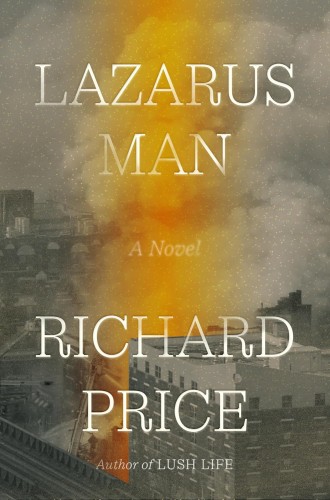The buried and the unburied
Richard Price’s latest novel follows four characters, each affected by the collapse of a tenement building in East Harlem.

Lazarus Man
A Novel
Imagine waking up beneath the rubble of a fallen five-story tenement in East Harlem three days after its collapse. You’re bruised and sore, your lungs on fire from the dust and fibers you’ve inhaled during your days of limbo, but otherwise you are unscathed. Would you see this as a second chance at life? No one would have expected to find you alive. Everyone would consider your survival a miracle. Would you have a message for the people astonished by your continued existence? What would you tell them? What would you do?
These are the questions Richard Price explores in Lazarus Man. Yet he doesn’t ask the questions early. The novel focuses elsewhere for roughly the first third of its 337 pages before pulling the Lazarus man, Anthony Carter, out of the rubble. That delay begs us to ask why it exists. What purpose does it serve to introduce Anthony at the beginning of the novel and then set him aside to focus on other characters for roughly 100 pages after the collapse of the tenement sets everything in motion in the novel’s brief first act? What’s the story here?
Read our latest issue or browse back issues.
According to some reviewers, there’s not much of a story at all. Apart from the precipitating event, the building’s collapse, there’s not much capital-D Drama. Instead, for 100 pages, Price focuses on the smaller stories that play out in the wake of the larger destruction. These stories follow three characters who each have a different connection to the collapse. Felix Pearl is a young aspiring photographer who lives in an apartment close to the explosion and responds to the building’s collapse by snapping pictures. Royal Davis is the owner of a dying funeral home who wonders if the collapse might lead to better business. Mary Roe is a community affairs officer and former detective tasked with identifying the tenement’s residents, both listed and unlisted, as well as its victims and survivors.
Throughout the novel’s second act, we follow these characters as they react to the fallout of the building collapse, which echoes and evokes the street-level chaos that followed the collapse of the Twin Towers. More importantly, however, we also follow Felix, Royal, and Mary as their paths lead them away from the fallout and back into the complexities of their lives and relationships. Given how large, loud, and important the novel’s central event seems, it’s notable that we spend most of the second act inundated with the mundanity of Felix’s insecurity and imposter syndrome, Royal’s inadequacies as a businessman and father, and Mary’s disconnected relationships with her children, her ex-husband, and the lover who wants to make more of their affair than she does.
The contrast between the import of the tenement’s collapse and the mundanity of our protagonists’ personal concerns dominates the novel’s second act, until the third act turns the novel in a new direction when Anthony figurately returns from the dead. Fortunately, Price does an excellent job of bringing his characters and their situations to life. Most reviews applaud the authenticity of Price’s urban details and dialogue, and I agree with their assessment.
Many of the novel’s best scenes illustrate the different ways people find just to get by in a city like New York. Such is the case in one scene where Mary and her partner Billy arrive at an attempted bank robbery and find the robber ready and willing to accept his fate:
“What’s your name?” Mary asked.
“Tony G.”
“Tony G, you tried to rob that bank?”
“Yeah, but I changed my mind.”
“You gave the teller a note?”
“I did, yes, but I took it back.”
“Well, you can’t unpass a note,” Bobby said, reaching for his cuffs.
“He knows that,” Mary grunted, double-pissed and then some.
“That being said, I wasn’t unpleasant to the young lady,” Tony G offered, “You can ask her.”
“Yeah, ok.”
“So, what now?” he asked as the cuffs hit home.
“What do you think?” Mary asked.
“State or federal?”
“Fed crime, fed time.” Mary again.
“How much time?”
“Two, three years, minimum.”
“Ok.”
It’s scenes like this—and their vibrant, clear-eyed exploration of urban life—that cause me to believe the reviewers who complain that the novel suffers for the lack of a clear plot are missing the point. The sudden, unexpected deaths caused by the tenement’s collapse spotlight the fact that while the novel’s three active protagonists are very much alive, their lives are broken and hollow. Throughout the second act, Price doesn’t make this point clear by telling us. He makes it clear by showing us. He roots us in his characters’ thoughts, and we become sympathetic to their lives and struggles.
Thus, when Anthony reappears in the third act and begins to inspire audiences with the story of his miraculous recovery, Price has prepared us to detect his other protagonists’ nuanced reactions. Royal and Felix respond to Anthony with varying levels of skepticism and opportunism based on their own deepest concerns, and Mary finds herself torn. Anthony’s appearance and his messages of joy speak to the emptiness in her life, but her detective’s instincts leave her uneasy. Something in his delivery and demeanor puts her off, and it nags at her even as she tries to track down the last of the names on her list from the tenement’s residents.
Mary’s detective work takes on greater importance throughout the third act when it functions like the plot element that moves the story forward. It also serves as the grit that balances Anthony’s new optimism and his inspiring message of gratitude. Indeed, Anthony’s gratitude for his second chance at life, contrasted with the protagonists’ daily grinds, truly drives the third act. Anthony has his doubts and his moments of weakness, but the novel is buoyant and uplifting when he shares his message with others, and even when he taps into the wellspring of gratitude to recharge his own outlook.
Ultimately, Mary’s investigations provide us something of a plot that Price resolves by the end of the book, but the resolution of this plot feels forced. As Price weaves the strands together, the writing becomes increasingly terse and practical. We stop exploring the protagonists’ inner lives with such care and patience. In the end, Price allows Anthony a line that seems to serve as the novel’s lesson: “Believe in that higher power, lean on it if that’s what you need to do, but for God’s sake believe in yourself. Think of where you’ve been, think of what you’ve already endured then tell yourself . . . ‘And yet, and yet, here I still am.’”
When Anthony says these words, however, the novel feels incomplete. Too much about the characters feels unresolved. It feels as if some threads were wrapped up too easily, others were forgotten, and others had so much potential for further exploration that it’s a shame to leave them.
Even though Lazarus Man ends too abruptly, Price deserves considerable credit for asking big questions and exploring the answers primarily through careful examination of his characters’ lives and situations. He presents us with questions and allows us to look for answers amid the emotional struggles he creates and defines. We may or may not see ourselves among the novel’s protagonists, but we will find echoes of our personal struggles with the weight and tedium of existence, of experiencing gratitude in our moments of epiphany, and of the joys we feel when we don’t just realize but truly feel that life is a gift. Lazarus Man may be an imperfect novel, but we humans are all imperfect, and Price succeeds tremendously in tapping deeply into our shared humanity.





